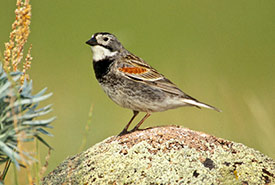
Thick-billed longspur (Photo by Alan MacKeigan)
Thick-billed longspur
An uncommon sight but a truly rewarding one if you are lucky to catch a glimpse, the thick-billed longspur puts on an aerial courtship display that rivals the best of human acrobats. Like a parachuter keen to impress, displaying males fly up while singing a warbling song and “float” gently back to the ground with spread wings and fanned tail, still in song.
As a native grassland habitat specialist endemic to the northern Great Plains of North America, thick-billed longspur is an indicator species that signals the health of the habitat that they live in. The longspur in its name describes the elongated claw on its hind toe.
What does the thick-billed longspur look like?
Thick-billed longspur is a greyish brown, medium-sized sparrow-like bird. The male has a black crown and chest, rust-coloured shoulder, with a white tail showing an inverted T pattern in black. The female is dull greyish brown with the same tail pattern as the male.
Where does the thick-billed longspur live?
Thick-billed longspurs spend the summer breeding, from southeastern Alberta to southwestern Saskatchewan, south through Montana and eastern Wyoming. Their wintering range extends from the southwestern U.S. to northern Mexico. This species prefers dry, almost barren short-grass prairies. They can be found in places such as cultivated farm fields during migration and the winter. During breeding season, they can be found in habitats such as dry lakebeds, pastures and closely grazed mix-grass prairies.
They nest on open ground, right next to small shrubs, piles of cow manure or a large clump of grass. Their nest site is a depression in the ground lined with nesting material, including grasses, animal hairs and plant fibres.
What is the thick-billed longspur's conservation status?
Thick-billed longspur has been assessed as threatened under the Committee on the Status of Endangered Wildlife in Canada.
Thick-billed longspur populations are declining due to loss of their native grassland habitat. The species’ population has declined 96 per cent from 1970 to 2019, according to the North American Breeding Bird Survey, and Partners in Flight estimates that there is a breeding population of 268,000 birds in Canada.
What is NCC doing to protect habitat for the thick-billed longspur?
The Nature Conservancy of Canada’s (NCC’s) Old Man on His Back Prairie Heritage and Conservation Area (OMB) is a stellar example of large-scale conservation of ecologically significant habitat that supports many grassland species, including thick-billed longspur. This expanse of semi-arid grassland, totaling 5,297 hectares, is a beacon of hope for the remaining mixed-grass prairies in Saskatchewan and Alberta that are rapidly disappearing due to cropland conversion.
Starting in 2017, NCC has been conducting surveys for grassland songbirds on several of our properties every year, including OMB. Thick-billed longspur was detected on OMB in 2017, 2018 and 2019; previous records also documented the species on the property in 2010 and 2013. In 2020, this specie was documented on other properties in the Milk River Basin Natural Area, including Zen-ridge. NCC plans to continue to conduct grassland songbird surveys in the coming years to ensure management of the property provides suitable habitat for the entire grassland songbird community. Since 1996, NCC has actively managed OMB as a working ranch, demonstrating how ranching can be used as a management tool for grassland birds.
In Alberta, this species has been found on NCC’s Sandstone Ranch and Haugan property.





